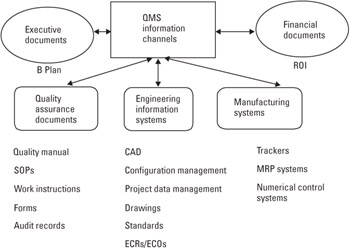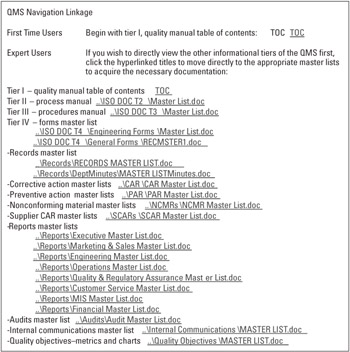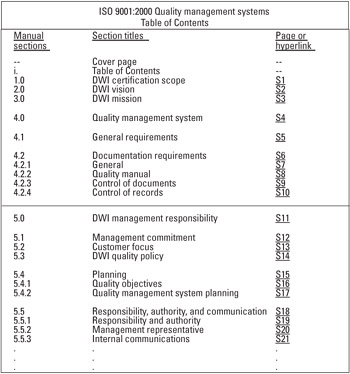4.3 The ISO 9001:2000 QMS Is To Be Documented
|
4.3 The ISO 9001:2000 QMS Is To Be Documented
The Standard demands a documented QMS. Within this mandated documentation are to be found the means to do the following [5]:
-
Identify QMS processes;
-
Determine process sequence and interaction;
-
Determine operational and monitoring criteria;
-
Determine operational and monitoring methods;
-
Monitor processes;
-
Measure processes;
-
Analyze processes;
-
Achieve planned results;
-
Achieve continual improvement of such processes.
So the key question here is how do you document these nine mandatory requirements? In other words, how do I document identified processes? How do I document the sequence and interaction of these processes? Our answer is to use a tier II document that can be either contained within the quality manual or referenced to another text from the quality manual. An agreement that this process document is a viable response to these nine requirements will validate the use of the proposed four-tier documentation structure.
With this assumption in mind, it is now necessary to establish that the following documents are the desired complete hierarchal set of documents, either defined or implied, in the Standard:
-
A documented quality policy (tier I);
-
Documented quality objectives (tier I);
-
A documented quality manual (tier I);
-
Six specifically defined documented procedures (tier III);
-
Documents that ensure the effective planning, operation, and control of processes (we logically conclude that this implies):
-
Process documents/SOPs/quality plans (tier II);
-
Procedures/work instructions (tier III);
-
Forms (tier IV);
-
-
Records (filled and filed forms that can occur at any tier level).
Of the six types of recommended global documents categorized here, records are the least understood with regard to their position in the documentation hierarchy. In fact, records (i.e., historical documents or documents used as objective evidence of activity) are distributed across the elements and can occur at any level of the hierarchy. For example, management review minutes are generated at the tier I level, quality plans and routers/travelers in the form of medical device history formats are required at the tier II level, and inspection and test reports are introduced at the tier III level.
To term records as being a specific tier is inappropriate. Records are a separate category and, in this regard, the Standard recognizes that that they are a special type of document and require document control [6].
4.3.1 Information Channel Management
In a more graphical sense, Figure 4.4 indicates the several possible channels of information that are covered under the suggested QMS four-tier concept [7]. Documents add up very quickly—a small company will reach hundreds of documents and a larger company will reach thousands of documents by the time they apply for certification. The number of documents will be proportional to the number of organizational functions and operating divisions. In addition, it is important to include controlled documents for field sales and field service personnel who are in residence outside of the main site's location but who must be kept up to date on revisions to the controlled documentation. Many companies now use online systems for this purpose.

Figure 4.4: Potential QMS information channels.
4.3.2 Mandatory Tier II Linkage Requirements
Linkage is also defined in the Standard in that the quality manual is to either include the required procedures or reference them [8]. As a result, the tiers should be clearly linked so that it is possible to readily navigate throughout the documentation. One of the more effective ways to link documents is illustrated in Figures 4.5 and 4.6. In this case, the organization has used electronic media to control the quality manual. This online document exemplifies the nature in which the lower tier documents can be linked via hyperlinks and the various sections within the quality manual itself can be linked via bookmarks.

Figure 4.5: David Wayne Industries online quality manual cover page.

Figure 4.6: David Wayne Industries online quality manual partial table of contents (TOC).
In practice, it is common to find the QMS defined primarily by the Quality Management Documents channel, with the Engineering Information Systems and Manufacturing Systems channels weakly described. The day-to-day interplay between engineering, operations, and quality assurance requires that all channels be equally efficient.
This was the reason, in the past editions of the Standard, that it was inefficient to certify a design and manufacturing facility to ISO 9002 and then seek a future audit to complete the certification to ISO 9001. The number of daily interfaces with engineering requires interface procedures. It is essentially the same effort to simply do the entire facility to ISO 9001 than to create all of those interface documents. The 2000 release resolves this issue because all certificates are to ISO 9001, and you are required to clearly justify why you have not complied with a specific clause required in Section 7, Product Realization.
The next step requires a careful examination of the Standard's mandatory QMS documentation requirements taken stepwise through the four tiers.
[5]ISO 9001:2000, Clause 4.1.
[6]ISO 9001:2000, Clause 4.2.3.
[7]The exponential increase of electronic media-based systems is concurrent with the explosion in information technology. It is now common to see electronic documentation control systems in use in parallel with MRP/ERP manufacturing control systems. Electronic calibration control systems are commonplace.
[8]ISO 9001:2000, Clause 4.2.2.
|
EAN: 2147483647
Pages: 155